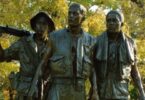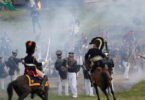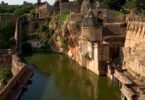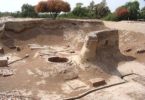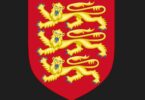When did Gandhi break the salt laws during the Dandi March?
(a) 31 March 1930
(b) 6 April 1930
(c) 10 April 1930
(d) 15 March 1930
When was Mahatma Gandhi arrested during the ‘Quit India Movement’ of 1942?
(a) 7th August 1942
(b) 30th April 1942
(c) 9th August 1942
(d) 5th July 1942
Some of Gandhi’s ideas were included as Directive Principles in which articles of the Indian Constitution?
(a) Article 40, 44, 45 and 50
(b) Article 41, 42, 43 and 44
(c) Article 40, 43, 47 and 48
(d) Article 41, 44, 50 and 51
Which of the following is not correct about Mahatma Gandhi?
(a) He advocated complete separation of politics from religion.
(b) He believed in non–violence
(c) He believed in non-sin of means.
(d) He supported the close relation between religion and politics.
Mahatma Gandhi was first arrested during ‘Satyagrah’ in the year—
(a) 1906
(b) 1908
(c) 1913
(d) 1917
Related: Child Psychology MCQs with answers
Mahatma Gandhi for the first time practiced his Satyagraha in India at
(a) Chauri-Chaura
(b) Ahmedabad
(c) Champaran
(d) Nauokhali
Gandhiji started the Civil Disobedience Movement in:
(a) January 1930
(b) January 1928
(c) March 1930
(d) March 1934
MK Gandhi was influenced by the writings of
(a) Lenin
(b) Leo Tolstoy
(c) Karl Marx
(d) Bernard Shaw
Which of the following institutions was not founded by Mahatma Gandhi?
(a) Sabarmati Ashram
(b) Sevagram Ashram
(c) Vishwa Bharti
(d) Phoenix Ashram
Mahatma Gandhi got his inspiration for Civil Disobedience from :
(a) Tuoreau
(b) Ruskin
(c) Confucius
(d) Tolstoy
In 1934, Mahatma Gandhi Withdrew From Active Politics And Even Resigned His Membership Of The Congress Because
(a) Of The Failure Of The Civil Disobedience Movement
(b) The Political Climate Of India Was Unsuitable For Any Political Movement
(c) He Wanted To Devote Himself Fully To a Constructive Programme And Harij An Welfare
(d) Of His Opposition To The Desire Of Congressmen To Enter Legislatures Under The Government Of India Act Of 1935
Gandhiji started march to Dandi from:
(a) Dandi
(b) Sabarmati Ashram
(c) Gujarat
(d) Champaran
What was the ultimate goal of Mahatma Gandhi’s Salt Satyagraha?
(a) repeal of Salt Satyagraha
(b) curtailment of the Government’s power
(c) economic relief to the common people
(d) ‘Purna Swaraj’ for India
What did Gandhiji meant by ‘Sarvodaya’?
(a) Non-violence
(b) Upliftment of untouchables
(c) The birth of a new society based on ethical values
(d) Satyagraha
Gandhiji believed that
(a) End justifies means
(b) Means justify end
(c) Neither end justifies means nor means justify end
(d) End and Means both should be justified
The Famous Resolution on Non-Cooperation under the Inspiration of Mahatma Gandhi was adopted in a Special Session of Congress Held at Calcutta in
(a) September 1920
(b) December 1922
(c) October 1924
(d) November 1925
In 1930, Mahatma Gandhi started the Civil Disobedience Movement from
(a) Wardha
(b) Sevagram
(c) Sabarmati
(d) Dandi
The issue on which the Civil Disobedience Movement of 1930 was launched was
(a) equal employment opportunities for Indians
(b) the proposed execution of Bhagat Singh
(c) salt monopoly exercised by the British Government
(d) complete freedom
On September 20, 1932 Mahatma Gandhi began a fast unto death in Yervada Jail against :
(a) British repression of the Satyagrahis.
(b) Violation of the Gandhi-Irwin Pact.
(c) Communal award of Ramsay MacDonald.
(d) Communal riots in Calcutta.
Quit India movement started in which year?
(a) 1940
(b) 1942
(c) 1943
(d) 1944
Related: Plantagenet Dynasty Trivia Quiz
Who did Mahatma Gandhi recognize as his Political Guru?
(a) Pheroze Shah Mehta
(b) Bal Gangadhar Tilak
(c) Gopal Krishna Gokhale
(d) Dadabhai Naoroji
In 1939, Gandhiji allowed a close associate of his to lead a satyagraha. Who was he?
(a) K. T. Bhashyam in Mysore
(b) Jamnalal Bajaj in Jaipur
(c) Vallabh Bhai Patel in Rajkot
(d) Nebakrushna Chaudhri in Dhenkanal
Quit India movement was started by M.K, Gandhi in
(a) 1940
(b)1942
(c) 1945
(d) 1946
Which Directive Principle bears the direct impact of Gandhi’s moral philosophy?
(a) Equal pay for equal work
(b) Provision of free legal aid and advice
(c) Prohibition of the slaughter of cows
(d) Protection of the monuments of historical importance
Where did Mahatma Gandhi first did Satyagraha?
(a) Dandi
(b) Noakhali
(c) England
(d) South Africa
Mahatma Gandhi launched the Civil Disobedience Movement on March 12, 1930 by
(a) asking the viceroy through a letter containing an eleven point programme to remove The Evils Of The British Rule
(b) Dandi march to break the Salt Laws
(c) asking the people to take the Poorna Swaraj Pledge
(d) launching the Non-Payment of Taxes campaign
What was the reason for his support for decentralization of power?
(a) Decentralization ensures more participation of the people in democracy.
(b) India had decentralization of power in the past
(c) Decentralization was essential for the economic development of the country.
(d) Decentralization can prevent communalism
Which associate of Mahatma Gandhi, launched the ‘self-respect movement’?
(a) P. Thyagaraja Shetti
(b) Chhatrapati Maharaj
(c) E.V. Ramaswamy Naicker
(d) Jyotirao Govindrao Phule
The remark, “A post-dated cheque on a crumbling bank” is regarding the proposals of
(a) Simon Commission
(b) Cripps Mission
(c) Cabinet Mission
(d) Wavel Plan
In which year did Mabatrria Gandhi call off the Non-Cooperation Movement?
(a) 1920
(b) 1922
(c) 1925
(d) 1928
Related: Probability questions and answers
Which of the following, according to Mahatma Gandhi, is the strongest force in the world?
(a) Non-violence of the brave
(b) Non-violence of the weak
(c) Non-violence of the coward
(d) Non-violence of the down Trodden
In which of the following movements did Mahatma Gandhi make the first use of the Hunger Strike?
(a) Non-Cooperation Movement, 1920-22
(b) Rowlatt Satyagraha, 1919
(c) Ahmedabad Strike, 1918
(d) Bardoli Satyagraha
In which city Mahatma Gandhi did successfully lead Mill worker’s strike in 1918
(a) Bombay
(b) Madras
(c) Ahmedabad
(d) Calcutta
Related: questions about the Desert
Which scripture was called his ‘mother’ by Gandhiji?
(a) Ramayana
(b) The New Testament
(c) Bhagwat Gita
(d) The Holy Quran
What strategy did Gandhiji suggest for an employer-employee cordial relationship?
(a) trusteeship
(b) means
(c) sarvodya
(d) production
Mahatma Gandhi returned from South Africa in the year
(a) 1912
(b) 1916
(c) 1915
(d) 1914
The UN General Assembly declared his birth anniversary, October 2, as the
(a) International Day of Non-violence
(b) International Day of Cooperation
(c) International Day of Peace and Cooperation
(d) International Day of Peace and Nonviolence
Who led the Salt Satyagraha Movement?
(a) Annie Besant
(b) Mridula Sarabhai
(c) Muthu Lakshmi
(d) Sarojini Naidu
Related: Political leaders of India
At the death of Gandhiji who said, “Light has gone from our Iives”?
(a) Dr. Rajendra Prasad
(b) Pt Jawaharlal Nehru
(c) Dr. S. Radhakrishnan
(d) Lord Mountbaten
Who Contemptuously Referred To Mahatma Gandhi As A Half-Naked Fakir?
(a) Lordwavell
(b) Lord Irwin
(c) Lord Willingdon
(d) Winston Churchill
Who scripted Gandhiji’s favorite song ‘Vaishnav Jan To ……” ?
(a) Narsinh Mehta
(b) Premanand
(c) Chunilal
(d) Dharmiklal
What is Gandhi’s definition of Rama Raj?
(a) The rule as it was during the time of Rama
(b) Sovereignty of the people based on pure moral authority
(c) The greatest good of all
(d) The absolute power concentrated in the hands of a king
Mahatma Gandhi founded and lived at an Ashram on the bank of river Sabarmati near the city of Ahmedabad when he was not traveling across India or in prison. It was known as:
(a) Sabarmati Ashram
(b) Swaraj Ashram
(c) Harijan Ashram
(d) Satyagraha Ashram
Related: Ancient Egypt questions
Where is the Gandhi Memorial Museum present?
(a) Gandhi Nagar, Gujarat
(b) Champaran, Bihar
(c) Madurai, Tamil Nadu
(d) Ahmedabad, Gujarat
Gandhi’s inspiration for Civil Disobedience came from the writings of
(a) Henry David Thoreau
(b) David Ricardo
(c) Henry Kissinger
(d) Bertrand Russell
Through which principle/device did Mahatma Gandhi strive to bridge economic inequalities?
(a) Abolition of machinery
(b) Establishment of village industries
(c) Adoption of non-violence
(d) Trusteeship theory
Mahatma Gandhi was assassinated by—
(a) Shivrao Pendse
(b) Tukaram Bhalerao
(c) Nathuram Godse
(d) Dilip Gode
The Gandhi-Irwin Pact is associated with
(a) Quit India Movement
(b) Civil Disobedience Movement
(c) Non-Cooperation Khilafat Movement
(d) Rowlatt Agitation
Related: international personalities quiz questions
In which Satyagraha movement of Mahatma Gandhi women participated most?
(a) Quit India
(b) Non-cooperation
(c) Salt
(d) Bardoli
Which of the following movements was NOT led by Mahatma Gandhi?
(a) Champaran Satyagraha
(b) Wahabi Movement
(c) Non-Cooperation Movement
(d) Civil Disobedience Movement
Gandhiji considered Khadi as a symbol of
(a) industrialization
(b) economic independence
(c) economic growth
(d) moral purity
Gandhi started the ‘Dandi March’ from
(a) Ahmedabad
(b) Allahabad
(c) Dandi
(d) Calcutta
Mahatma Gandhi undertook a fast unto death in 1932, mainly because
(a) The Round Table Conference failed to satisfy Indian political aspirations
(b) Congress and the Muslim League had differences of opinion
(c) Ramsay Macdonald announced the Communal Award
(d) None of the statements
The Dandi March of Gandhi is an example of
(a) Direct Action
(b) Boycott
(c) Civil Disobedience
(d) Non-Cooperation
In Gandhian Socialism
(a) State is required
(b) State is not required
(c) State is sometimes required and sometimes not required
(d) State is neither required nor not required
Mahatma Gandhi began his political activities in India first from:
(a) Dandi
(b) Kheda
(c) Sabarmati
(d) Champaran


